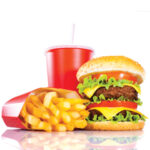Key Facts
- Fast food is food from a restaurant (sit-down, take-out, or delivery) that is quick, convenient, and usually cheap.
- Depending on what fast food you get, it may be higher in calories (energy), saturated fat, and sodium than what your body needs at a specific mealtime. Eating these foods frequently can increase risk for health problems, such as high blood pressure and heart disease.
Fast food refers to food that can be prepared and served quickly. It can come from many places: sit-down restaurants, counter service, take-out, drive-thru, and delivery. Fast food is popular because the food is inexpensive, convenient, and tastes good. Fast food may include refined grains instead of whole grains, contain saturated fat, cholesterol, and added sugar, and it can be high in sodium (aka salt) which is used as a preservative and makes food more flavorful and satisfying.
Is fast food unhealthy?
While some foods are healthier than others, there is no such thing as a “bad” food. Different foods can serve different purposes, but they are all providing us with energy and nutrients that our body needs. For example, pizza contains nutrients such as carbohydrates, protein, fat, calcium, and others depending on the toppings. A salad with grilled chicken and dressing contains nutrients such as protein, carbohydrates, fat, fiber, vitamin A, vitamin C, and more. People tend to think of fast food as being unhealthy because there are often many choices that have been fried and historically the portions tend to be “super” sized. Depending on what fast food you get, it may be higher in calories (energy), saturated fat, and sodium than what your body needs at a specific mealtime. Also keep in mind that soda, often featured prominently at fast food restaurants, has a lot of added sugar which is generally not necessary in the diet.
Is some fast food healthier than others?
Many fast food chains have updated their menus to include more nutritious options, such as meals that contain fruits and vegetables. Keep in mind that lower calorie menu options are not necessarily “healthier.” For example, french fries might be lower in calories than a grilled chicken sandwich, but you’d be getting more protein if you choose the sandwich and more dietary fat if you choose the fries. You can also often look at the nutrition facts on the restaurant’s website if you’re curious. Many of these menus are now interactive as well, so you can preview your plate and modify it to be more nutritious by finding the choices that are higher in protein and fiber and lower in saturated fat and sodium.
Here are some additional tips:
Choose whole grains
Whole grains provide fiber, which can help to maintain steady blood sugar and help to lower cholesterol, vitamins, and minerals. To include whole grains in your fast food meal, try:
- Whole wheat bread, wrap, tortilla, or pizza crust
- Brown rice
- Quinoa
- Oats
Add fruits and veggies
- Top your sandwiches with veggies such as onions, lettuce, peppers, and tomatoes
- Try fruit and yogurt for a side.
- When ordering pizza, add veggies.
- Try a salad, steamed vegetables, fruit, or soup on the side.
Make a balanced meal
Here are a few ideas to order a balanced meal when choosing fast food:
- Grilled chicken sandwich with a side salad or apple slices.
- Whole wheat sub or pita with lean protein (grilled chicken, turkey), plenty of vegetables, and an oil-based dressing or hummus.
- Burrito with a whole wheat tortilla (or in a bowl), with brown rice, vegetables, and lean protein (beans or chicken) or choose tacos with lean protein (fish, chicken, or beans) and vegetables. For a topping, try guacamole or salsa.
Tune into your hunger and fullness cues and enjoy your meal
Consider what you are hungry for.
- Think about flavors, scents, textures, and temperature when deciding what will bring you the most satisfaction.
- Sit down while you eat. Fast food is known as a meal on the go. Many people eat in their cars or while doing another activity. If possible, sit down at the table and put away electronic devices so you can fully enjoy your meal. If you are distracted, you may not pay attention to your hunger and fullness cues.
Everyone has different energy and nutrient needs, so the size of the meal may be smaller or larger than what your body needs. By listening to your hunger and fullness cues, it can help you decide if you need more food to satisfy your needs or if you want to save some of your meal for later when you’re hungry again.
Other tips
- Choose foods that are broiled, steamed, or grilled rather than fried.
- Asking for sauces on the side can help you be able to choose the portion you’d like.
- If you like the fizz of soda, you might try seltzer water that is naturally flavored without added sugar. Water with different fresh fruits in it can also be a fun alternative to try.
Our health guides are developed through a systematic, rigorous process to ensure accuracy, reliability, and trustworthiness. Written and reviewed by experienced healthcare clinicians from Boston Children's Hospital, a Harvard Medical School teaching hospital and consistently ranked as a top hospital by Newsweek and U.S. News & World Report, these guides combine clinical expertise, specialized knowledge, and evidence-based medicine. We also incorporate research and best practices from authoritative sources such as the CDC, NIH, PubMed, top medical journals, and UpToDate.com. Clinical specialists and subject matter experts review and edit each guide, reinforcing our commitment to high-quality, factual, scientifically accurate health information for young people.


